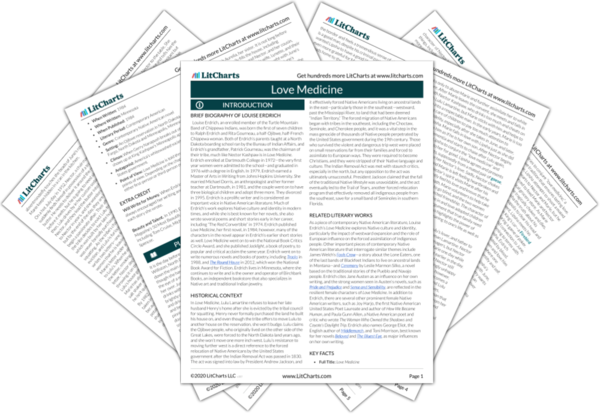Louise Erdrich, an enrolled member of the Turtle Mountain Band of Chippewa Indians, was born the first of seven children to Ralph Erdrich and Rita Gourneau, a half-Ojibwe, half-French Chippewa woman. Both of Erdrich’s parents taught at a North Dakota boarding school ran by the Bureau of Indian Affairs, and Erdrich’s grandfather, Patrick Gourneau, was the chairman of their tribe, much like Nector Kashpaw is in
Love Medicine. Erdrich enrolled at Dartmouth College in 1972—the very first year women were admitted to the school—and graduated in 1976 with a degree in English. In 1979, Erdrich earned a Master of Arts in Writing from Johns Hopkins University. She married Michael Dorris, an anthropologist and her former teacher at Dartmouth, in 1981, and the couple went on to have three biological children and adopt three more. They divorced in 1995. Erdrich is a prolific writer and is considered an important voice in Native American literature. Much of Erdrich’s work explores Native culture and identity in modern times, and while she is best known for her novels, she also wrote several poems and short stories early in her career, including “The Red Convertible” in 1974. Erdrich published
Love Medicine, her first novel, in 1984; however, many of the characters in the novel appear in Erdrich’s earlier short stories as well.
Love Medicine went on to win the National Book Critics Circle Award, and she published
Jacklight, a book of poetry, to popular and critical acclaim the same year. Erdrich went on to write numerous novels and books of poetry, including
Tracks in 1988, and
The Round House in 2012, which won the National Book Award for Fiction. Erdrich lives in Minnesota, where she continues to write and is the owner and operator of Birchbark Books, an independent bookstore that also specializes in Native art and traditional Indian jewelry.
